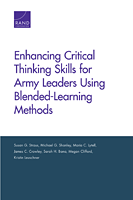| 来源类型 | Research Reports
|
| 规范类型 | 报告
|
| ISBN | 9780833079091
|
| 来源ID | RR-172-A
|
| Enhancing Critical Thinking Skills for Army Leaders Using Blended-Learning Methods |
| Susan G. Straus; Michael G. Shanley; Maria C. Lytell; James C. Crowley; Sarah H. Bana; Megan Clifford; Kristin J. Leuschner
|
| 发表日期 | 2013
|
| 出版年 | 2013
|
| 页码 | 168
|
| 语种 | 英语
|
| 结论 |
Students Were Generally Satisfied with the Course- The majority of students felt that AOC-BDL achieved its core purpose. Most were satisfied with computer-based instruction, instruction of operational topics, and aspects of the learning environment, such as instruction quality and peer interaction and feedback.
Students Noted that the Distributed Environment Posed Challenges to Meeting Course Goals- Students reported that computer-supported collaborative learning impeded some course goals, particularly for complex topics, such as the military decision making process. Students also cited challenges to group coordination due to technology reliability and access, competing commitments, and difficulties working across time zones.
Although Many Blended-Learning Courses Have a Face-to-Face Component, In-Person Instruction May Not Be Possible in all Situations- Adding a resident segment to AOC-BDL may offer the greatest potential for improvement and is consistent with student preferences and best practices. However, this option may not be feasible due to available infrastructure, costs, and operational manning requirements. Consequently, other strategies become particularly important to consider.
Cases Studies of BDL and Related Research Point to Best Practices and Options for Improvement- Successful BDL programs find ways to reduce conflicts with students' other commitments. Two strategies include limiting the use of synchronous modalities and engaging students' employers to dedicate time for students' coursework. Instructors use a variety of approaches to engage students and foster success in virtual collaboration, including training students in use of course technology, scaffolding discussions, providing timely feedback, limiting group size for interactive activities, and using peer evaluations to increase accountability in teams.
|
| 主题 | Educational Technology
; Military Education and Training
; Military Officers
; Organizational Leadership Development
; United States Army
|
| URL | https://www.rand.org/pubs/research_reports/RR172.html
|
| 来源智库 | RAND Corporation (United States)
|
| 资源类型 | 智库出版物
|
| 条目标识符 | http://119.78.100.153/handle/2XGU8XDN/107491
|
推荐引用方式
GB/T 7714 |
Susan G. Straus,Michael G. Shanley,Maria C. Lytell,et al. Enhancing Critical Thinking Skills for Army Leaders Using Blended-Learning Methods. 2013.
|
|
文件名:
|
1374062418763.gif
|
|
格式:
|
GIF
|

|
文件名:
|
RAND_RR172.pdf
|
|
格式:
|
Adobe PDF
|
除非特别说明,本系统中所有内容都受版权保护,并保留所有权利。